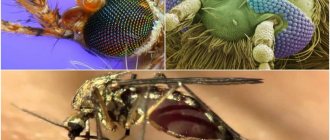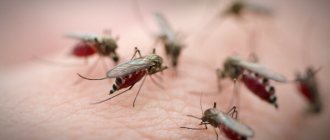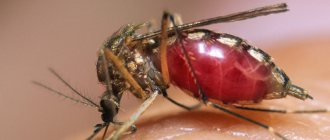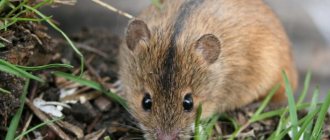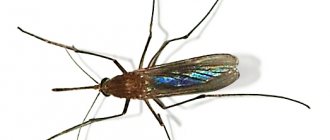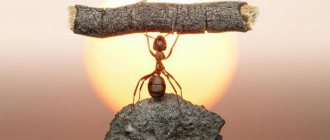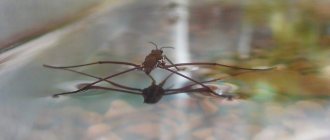Field mouse: description
Description of the field mouse:
- Body length no more than 12 cm, excluding tail. The thin tail makes up 70% of the body length.
- The body is oblong. The hind feet are elongated and protrude forward when running.
- Long muzzle, small round ears, oblong nose.
The fur is hard, rough, short. The colors can be different - gray, brown, ocher or beige. A straight line of black or brown shade runs along the spine. The color of the abdomen is snow-white. At the base the hairline has a dark tint. Small spots may be present on the chest.
This is interesting! The shade of the animal's fur depends on its age. The older the field mouse, the lighter its fur. With age, the dark base of the hairline begins to lighten. Individual hairs may be gray.
The vole mouse has unique teeth ; a pair of long incisors on the lower jaw grow throughout its life. To prevent their excessive growth, and they grow at a rate of 1-2 mm per day, the mouse is forced to continuously grind them off against hard objects.
As for weight, the average animal does not weigh more than 20 grams.
Photo
Distribution of animals
This representative of the fauna is widespread in Europe. Animals can also be found in China, Mongolia, Denmark, Finland, Korea, and Taiwan. In the Russian Federation, the rodent is distributed in Primorye, Siberia, and the Urals. Often settles on the hills, climbs low into the mountains.
Found near the Black and Azov Seas. Does not like deserted forest-steppes and continuous forests. It takes root well in moist interfluves .
It prefers overgrown meadows with small depressions, collective farm fields, sunny edges of deciduous forests and, of course, vegetable gardens. It can be found in greenhouses, greenhouses, cellars, barns, abandoned utility sheds and even in residential premises.
IMPORTANT! With the onset of autumn, rodents move into stacks, haystacks, and stacks of straw.
Reproduction
The breeding season for the vole mouse is from early spring to mid-autumn. In one season, the animal is capable of producing 3-4 offspring . In rare cases, up to 5-6. Gestation of the cubs lasts 21-23 days. One litter usually produces 5-7 babies.
Babies are born helpless and blind, but they develop very quickly.:
- 12-14 days after birth they begin to see clearly.
- 30 days after birth they become independent.
- Young individuals are capable of giving birth to cubs within 90-105 days after birth.
How long does a field mouse live? The lifespan of a field mouse can reach 7 years, but in the wild the animals usually live for a year or two.
Now imagine how quickly rodents can multiply in just one summer season, provided there is an abundance of food and sun.
What do cubs, reproduction and offspring look like?
Voles are fertile animals. Females give birth up to six times a year, and up to 7 cubs can be born. They are born absolutely helpless, without hair, unable to distinguish between surrounding objects. The female takes all care of the offspring - warms it with her body, feeds it, protects it from attacks by predators who love to feast on delicate little mice.
Vole pregnancy lasts about three weeks. And after ten days, the mouse is again ready for fertilization, even despite the helplessness of newborns. Cubs reach sexual maturity after three months. But long before that, they learn the skills of finding food and protecting themselves from predators.
Lifestyle
In summer and spring, field mice are active in the evening and at night. In autumn and winter they can be active during the day. They do not hibernate.
How mice and voles overwinter:
- Natural shelters or earthen passages can be used as burrows.
- Their burrows reach 3-4 m in length and have 2-4 exits, one of which leads to a watering hole.
- Dwellings must have a nesting chamber and 2-3 pantries in which winter supplies are stored.
- The storerooms are located at a depth of 0.5-1 m.
IMPORTANT! Rodents that live in swampy areas do not dig burrows. They build nests. The main material is grass. Such dwellings are usually located on tall bushes.
What does it eat, where is it included in the food chain?
Voles eat a wide variety of plants: shrubs and grasses, bark, shoots, leaves and fruits of trees and shrubs, mosses, lichens, mushrooms, insects, worms and even small vertebrates (for example, frogs).
We suggest you read: What do house flies eat?
REFERENCE: There are known cases where mice completely destroyed the seeds of beech, maple and linden in forestry. They can also destroy sown and sprouted seeds of agricultural crops on a large scale.
This is what the wood mouse eats in the forest - the seeds of deciduous trees.
In second place in preference are berries and small insects, but they rarely eat green leaves, only if they are very hungry. This usually happens in the spring, when there is an abundance of fresh greens, but there are no seeds and berries yet.
Since this species of mouse is known to be active all year round, this makes them easy prey for predators.
Their numbers are regulated by owls, ferrets and weasels. In winter, foxes can also enjoy them.
IMPORTANT: Despite the significant damage they cause to green spaces, hedgehogs, snakes and birds of prey could not survive without wood mice. For the latter, this is especially important in winter.
Distinctive features
Vole mice have their own characteristics that are distinctive from other rodents.:
- Depending on their habitat (eastern and western), individuals have different colors and sizes.
- It differs from other rodents by the presence of a smooth stripe along the spine.
- Unlike mice, it has a larger body size.
- It differs from the Dahurian hamster in its longer tail.
- Unlike pieds, it has a longer period of puberty - about 100 days.
- Compared to other subspecies of rodents, the field mouse has an underdeveloped ear.
- Field mice have coarser fur. And adult individuals often develop soft spines, like hedgehogs.
- Field mice belong to the mobile subspecies. They are characterized by seasonal feeding movements.
- May be common in swampy areas. At the same time, they use grass nests as burrows.
Very often, other species of mammals that look similar to voles are mistaken for mice. The most common types of rodents that resemble mice in appearance are :
- Earth rat. Despite this name, this animal actually belongs to the mouse family, but differs from voles in its larger size.
- Mole voles. Lives underground and belongs to the hamster family.
And also rodents from the vole family:
- Yellow and steppe variegated. They are similar in appearance to mice, but have a number of distinctive features. Read more about pestles here.
- Red and bank voles. Forest dwellers, differing from the field ones in the color of their fur coat.
- Housekeeper vole. This species lives in colonies and is capable of making significant, up to 15 kg, reserves for the winter.
- Gray vole.
Read about different types of voles here.
Ways to fight and protect
The main difficulty in the fight against field mice is that they live in places hidden from human eyes. This means that catching or poisoning them is quite problematic. Therefore, the primary task in the fight against voles is the need to find and destroy their housing . You can do this in the following ways.
We drive mice away from the territory
First of all, you need to try to drive rodents out of the area:
- Mow tall grass, remove dry leaves and weeds. You also need to get rid of branches and piles of plant debris. All of these are great places to build burrows.
- Fruits that have fallen from the tree should not remain on the site, as they are an easily accessible source of food for voles.
- Digging up the area can help get rid of holes and underground passages.
- To prevent rodents from damaging fruit trees, a fine mesh net is dug into the ground around the trunks. The same can be done around the perimeter of the entire site.
We use repellers
The use of special repellent devices can speed up the process of expelling voles from your territory. They are installed around the perimeter of the site and provide protection from moisture.
We use mousetraps
Ordinary mousetraps can also help in the fight against mice. Experienced gardeners recommend installing these devices on the site in early spring and late autumn , since it is at this time that mice reproduce most actively. To prevent harm to pets, mouse traps can be covered with a box; this will not stop mice in pursuit of the bait.
We use poisons
At the end of winter and beginning of spring, the use of poisons is very effective. At this time, mice are hungry and not very picky about food. Poisons are placed directly in burrows.
Lifestyle and habitat
Mice reproduce quickly, they are hardy and adapt to almost any natural conditions. Therefore, you can meet them in any corner of the planet. They live in Siberia, the Volga region, Krasnodar and Stavropol territories. Vole nests are found even in northern India and in the arid regions of Mongolia and China. Mice raid crops in South and North America and the Scandinavian countries. But they are not able to live for a long time in a hot climate, therefore, starting from the desert regions of North Africa, rodents are not found.
Voles are animals that do not hibernate. That is, mice need a supply of grain for the entire winter. Here they do not limit themselves; they drag an abundance of food into their holes. One mouse can eat up to 4 kg of grain, which it simply cannot eat. Most of it dies, but at the same time releases the heat necessary to warm the winter shelter and nurse the offspring.
It is not entirely true that voles live only in deep, winding burrows underground. Many mice choose the hollows of trees, the places between their huge roots. Rodents thrive in haystacks that are not collected for the winter and in the attics of residential, including abandoned, premises. They can be found in barns, cattle sheds, poultry houses and pigsties.
Voles intuitively sense danger, so they do not build nests near rivers. After all, when they overflow their banks in early spring, mouse holes can be flooded along with their inhabitants.
How to get rid of field mice in the house?
If you have mice in your home, use time-tested, traditional methods.:
- Mousetraps. At the same time, do not forget about safety measures so that people and pets do not get hurt.
- Repellers. Special devices are safe for people and pets, but have a negative effect on mice.
- Poisons can be used if all precautions are taken.
- Cat. The most effective, proven and safe “remedy” for mice. If you don't have a cat at home, borrow one from friends for a while.
Thus, it is quite possible to get rid of mice on your property or in your house. It is enough to create unbearable living conditions for them. And to prevent voles from appearing again, prevention is needed - maintaining cleanliness in the area, timely removal of plant debris and food waste.
Prevention measures
To prevent voles from visiting your farm or summer cottage again, it is necessary to take a number of preventive measures. These include:
- keeping the site area clean (avoiding the accumulation of food and plant debris, old furniture and trash);
- periodically loosen the soil in the garden (such actions destroy the homes of voles);
- keep a cat or dog on the site (animals will scare away uninvited guests).
Some summer residents constantly lay out poison in basements and sheds, and also use adhesive compounds to prevent rodent infestations. It is important to carry out a set of preventive actions, then field mice will not be interested in such farming.
Sources:
https://parazitdoma.ru/krysy-i-myshi/spyat-li-myshi-zimoy https://zen.yandex.ru/media/geradez/kak-zimuiut-myshi-5c403995a3352000adce1cf9 https://vreditelisos.ru/ myshi/polevaya-mysh.html
